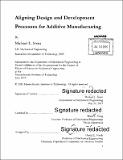Aligning design and development processes for additive manufacturing
Author(s)
Stern, Michael L., S.M. Massachusetts Institute of Technology
DownloadFull printable version (11.60Mb)
Other Contributors
Massachusetts Institute of Technology. Department of Mechanical Engineering.
Advisor
Maria C. Yang.
Terms of use
Metadata
Show full item recordAbstract
Rapid Prototyping has transitioned from only being able to produce delicate prototypes to being capable of producing robust production parts. As part of this transition, it has been renamed Additive Manufacturing (AM). As a true manufacturing technology, it has become important to deliberately design parts for Additive Manufacturing, and research has begun in how best to achieve this. This thesis explores the background of Additive Manufacturing, the growth in its use as a manufacturing technology, and the advantages and challenges of the technology. Following background information, this thesis progresses to different design approaches and technologies that promise to be effective when paired with AM. A design methodology using topology optimization is proposed, detailed and then tested on two case studies. The first case is a high-speed mirror for imaging and the second case is an aircraft bracket for the 2013 GrabCAD-GE design challenge. This thesis also includes an examination of the implementation of the proposed methodology on these case studies and the resulting designs. The design from both case studies achieved a greater than 60% weight reduction through the use of design methodology tailored for AM. The final section of the thesis shifts from the design process to the development process where the impact of AM is examined. In order to gain an understanding of the influence that Additive Manufacturing has on production, this thesis includes a synthesis of the literature from Additive Manufacturing as well as Design and Management. The benefits are approached from an economic perspective, reviewing the first order benefits that have been extensively studied and then progressing to the second order benefits, and indirect benefits, which have not been examined in detail before. To understand the full effect of Additive Manufacturing on product development, the consideration of advantages such as high fidelity prototypes, decreased risk, faster time to market and late stage design flexibility are assessed.
Description
Thesis: S.M., Massachusetts Institute of Technology, Department of Mechanical Engineering, 2015. Cataloged from PDF version of thesis. Includes bibliographical references (pages 83-88).
Date issued
2015Department
Massachusetts Institute of Technology. Department of Mechanical EngineeringPublisher
Massachusetts Institute of Technology
Keywords
Mechanical Engineering.